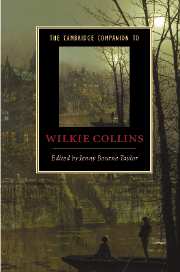Book contents
- Frontmatter
- Introduction
- 1 Collins’s career and the visual arts
- 2 The early writing
- 3 Collins’s shorter fiction
- 4 Collins and the sensation novel
- 5 The Moonstone, detective fiction and forensic science
- 6 The later novels
- 7 The professional writer and the literary marketplace
- 8 The marriage plot and its alternatives
- 9 Collins and Victorian masculinity
- 10 Collins and empire
- 11 Disability and difference
- 12 Collins and the theatre
- 13 The afterlife of Wilkie Collins
- Further reading
- Index
- Series List
2 - The early writing
Published online by Cambridge University Press: 28 January 2007
- Frontmatter
- Introduction
- 1 Collins’s career and the visual arts
- 2 The early writing
- 3 Collins’s shorter fiction
- 4 Collins and the sensation novel
- 5 The Moonstone, detective fiction and forensic science
- 6 The later novels
- 7 The professional writer and the literary marketplace
- 8 The marriage plot and its alternatives
- 9 Collins and Victorian masculinity
- 10 Collins and empire
- 11 Disability and difference
- 12 Collins and the theatre
- 13 The afterlife of Wilkie Collins
- Further reading
- Index
- Series List
Summary
In the early spring of 1856, Wilkie Collins completed the novella A Rogue's Life in a pavilion in the grounds of a house in the Champs Elysées in Paris rented by Charles Dickens. At thirty-two he could look back on twelve years of writing which demonstrated an extraordinary range in genre, including four novels (one unpublished), many short fictions, some just republished in his first story collection, After Dark (1856), a drama, a biography, a travel book and assorted journalism. A Rogue's Life, a satirical narrative, written on a sickbed, parodies his own search for a secure niche in the literary world. The Rogue, son of a fashionable doctor, quits medical studies to become 'one of the young buccaneers of British Caricature; cruising about here, there and everywhere, at all my intervals of spare time, for any prize in the shape of a subject which it was possible to pick up' (ch. 2). Confined to a debtors' prison, he produces prints of prison life. Released, he becomes an unsuccessful fashionable portrait painter, until an experienced friend introduces him to the market for forging Old Masters, where demand exceeds supply, and the recent demise of the Rembrandt specialist has left a gap in the market. Evading the legal consequences of his foray into forging Rembrandts, he is briefly the secretary to a provincial literary institution, before descending, again under the guidance of a senior partner, to the forging of currency. Transported to Australia, he finally reinvents himself as a wealthy ex-convict landowner.
- Type
- Chapter
- Information
- The Cambridge Companion to Wilkie Collins , pp. 23 - 36Publisher: Cambridge University PressPrint publication year: 2006
- 3
- Cited by



